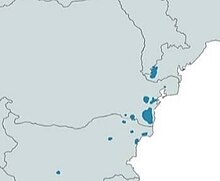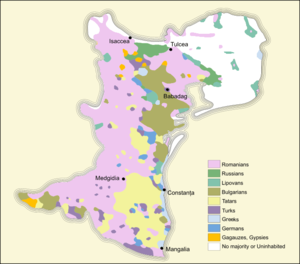Tatars of Romania
This articleneeds additional citations forverification.(April 2021) |
 | |
| Regions with significant populations | |
| Bulgaria,Romania,Moldova,Turkey | |
| Languages | |
| Dobrujan Tatar,Romanian,Bulgarian,Russian,Turkish | |
| Religion | |
| Sunni Islam | |
| Related ethnic groups | |
| Crimean Tatars,Nogais |
| Part ofa serieson |
| Crimean Tatars |
|---|
| By region or country |
| Religion |
| Language |
| Culture |
| History |
| People and groups |



TheTatars of Romania,Tatars of DobrujaorDobrujan Tatars[1][a]are aTurkicethnic group that have been present inRomaniasince the 13th century. According to the 2011 census, 20,282 people declared themselves as Tatar, most of them beingCrimean Tatars[3][4][5]and living inConstanța County.But according to theDemocratic Union of Tatar Turkic Muslims of Romaniathere are 50,000TatarsinRomania.They are one of the main components of theMuslim community in Romania.
History
[edit]Middle Ages
[edit]The roots of the Crimean Tatar community in Romania began with theCumanmigration in the 10th century. Even before the Cumans arrived, other Turkic peoples like theHunsand theBulgarssettled in this region. The Tatars first reached theDanube Deltain the mid-13th century during the power peak of theGolden Horde.In 1241, under the leadership of Kadan, the Tatars crossed the Danube, conquering and devastating the region. The region was probably not under the direct rule of the Horde, but rather, a vassal of theBakhchisarayKhan.[6]It is known from Arab sources that at the end of the 13th century and the beginning of the 14th century, descendants of theNogai Hordesettled inIsaccea.Another Arab scholar,Ibn Battuta,who passed through the region in 1330 and 1331, talks aboutBaba Saltuk(Babadag) as the southernmost town of the Tatars.[6]
The Golden Horde began to lose its influence after the wars of 1352–1359 and, at the time, a Tatar warlordDemetriusis noted defending the cities of the Danube Delta. In the 14th and 15th centuries theOttoman EmpirecolonizedDobrujawithNogaisfromBucak.Between 1593 and 1595 Tatars from Nogai andBucakwere also settled to Dobruja. (Frederick de Jong)
Early modern period
[edit]Toward the end of the 16th century, about 30,000 Nogai Tatars from theBudjakwere brought toDobruja.[7]
After theRussian annexation of Crimeain 1783Crimean Tatarsbegan emigrating to theOttomancoastal provinces ofDobruja(today divided betweenRomaniaandBulgaria). Once in Dobruja most settled in the areas surroundingMecidiye,Babadag,Köstence,Tulça,Silistre,Beştepe,orVarnaand went on to create villages named in honor of their abandoned homeland such as Şirin, Yayla, Akmecit, Yalta, Kefe or Beybucak.[when?]
Late modern period
[edit]From 1783 to 1853 tens of thousands of Crimean Tatars andNogaisemigrated to theRusçukregion which subsequently became known as "Little Tartary". Following the Russian conquest of 1812, Nogais from Bucak also immigrated to Dobruja. Tatars who settled in Dobruja before the great exodus of 1860 were known asKabail.They formed the Kabail Tatar squadron in theNizam-ı Cedid(New Order) army of sultanSelim III.They played a key role inMahmud II's struggle withMehmet Ali Pashaof Egypt, suppressed rebellions inBosnia and Herzegovina,Kurdistan,and the Arab provinces and served with the Ottomans during theCrimean War.[citation needed]
Tatars together with Albanians served asgendarmes,who were held in high esteem by the Ottomans and received special tax privileges. The Ottoman's additionally accorded a certain degree of autonomy for the Tatars who were allowed governance by their ownkaymakam,Khan Mirza. TheGiray dynasty(1427 - 1878) multiplied in Dobruja and maintained their respected position. A Dobrujan Tatar,Kara Hussein,was responsible for the destruction of theJanissarycorps on orders from Sultan Mahmut II.[citation needed]
From 1877-1878 it is estimated that between 80,000 and 100,000 Crimean Tatars emigrated from Dobruja toAnatolia,which continued in smaller numbers until World War I. The reasons for the emigration were several: In 1883 the Romanian government enacted laws requiring compulsory military service for all Romanian subjects including Tatars who were concerned that serving a Christian army was not in accord with their Muslim identity. Other reasons included the 1899 famine in Dobruja, a series of laws from 1880 to 1885 regarding confiscation of Tatar and Turkish land, and theWorld War I(1916–18) which devastated the region.[citation needed]
Early 20th century to WWII
[edit]
A unique Crimean Tatar national identity in Dobruja began to emerge in the last quarter of the 19th century.[8]WhenIsmail Gasprinski,considered by many to be the father of Crimean Tatar nationalism, visitedKöstence(Constanţa) in 1895 he discovered his newspaperTercümanwas already in wide circulation. However, it was the poetMehmet Niyaziwho is most credited with spreading nationalist ideas among the Tatars of Dobruja. In the wake of the fall of the Crimean Tatar government, Dobruja became the foremost place of refuge for Tatars from Crimea. Many of these refugees were inspired to join thePrometheus movementin Europe which aimed for the independence of Soviet nationalities. During this period Mustecip Hacı Fazıl (later took the surname Ulkusal) was the leader of community in Dobruja. In 1918, when he was 19 he went to Crimea to teach in Tatar schools and published the first Tatar journal in Dobruja,Emelfrom 1930 to 1940. He and other nationalists protested Tatar emigration from Dobruja to Turkey, believing resettlement inCrimeawas preferable.
In the 1920s Dobruja persisted as the primary destination for refugees escaping the Soviets. The Tatars were relatively free to organize politically and publish journals founded on nationalist ideas. DuringWorld War IImany Tatars escaped fromCrimeaand took refugee with Crimean Tatar families in Dobruja who were subsequently punished harshly byCommunist Romania.The refugees who attempted escape by sea were attacked by Red Army aircraft, while those who followed land routes throughMoldaviamanaged to reach Dobruja before the Red Army captured and deported most of them to Siberia on May 18, 1944. Necip Hacı Fazıl, the leader of the smuggling committee was executed and his brother Müstecip Hacı Fazıl fled to Turkey.[citation needed]
Developments Post-WWII
[edit]In 1940Southern Dobrujawas given to Bulgaria, and by 1977 an estimated number of 23,000 Tatars were living in Romania. According to Nermin Eren, that number increased to around 40,000 by the 1990s. In 2005 theDemocratic Union of Turkish-Muslim Tatars of Romaniaclaimed that there were 50,000 Tatars in Romania, believing the census estimate was artificially low because most Tatars identified themselves as Turks. Nermin Eren also estimated the number of Tatars in Bulgaria to be around 20,000 in the 1990s. The Bulgarian sources estimate it to be around 6,000, though they are aware that most Tatars intermarry Turks or identify themselves as Turks. Between 1947 and 1957, Tatar schools began operating in Romania, and in 1955 a special alphabet was created for the Tatar community. In 1990 the Democratic Union of Muslim Tatar-Turks was established. Currently Romania respects the minority rights of Tatars and does not follow any policy ofRomanianization.
Notable people
[edit]- Kázím Abdulakim
- Denis Alibec,footballer
- Melek Amet,fashion model
- Nejla Ateş
- Emin Bektóre
- Şahip Bolat Abdurrahim
- Dimitrie Cantemir
- Gelil Eserghep,politician
- Deniz Giafer,footballer
- Edris Fetisleam,tennis player
- Tahsin Gemil
- Yusuf Isa Halim,linguist
- Sîdîyîk Ibrahim H. Mîrzî
- Murat Iusuf,cleric
- Refiyîk Kadír
- Kemal Karpat
- Mehmet Niyazi,writer
- Ahmet Nurmambet
- Kadriye Nurmambet,musical artist
- Aihan Omer,handball player and coach
- Negiat Sali,politician
- Atila Septar,rugby player
- Erdinci Septar,rugby player
- Sevil Shhaideh,politician
- Septar Mehmet Yakub
- Taner Murat
- Ismail H. A. Ziyaeddin
Language
[edit]Dobrujan Tatar or Romanian Tatar is the Tatar language ofRomania.It includesCrimean TatarandNogaidialects,[9][10][11][12][13]but today there are no longer sharp distinctions between these dialects and it's mostly seen as one language.[14][15]This language belongs toKipchak Turkic languages,specifically to Kipchak-Nogai and is influenced byTurkishandRomanian.[14][15]
Subgroups
[edit]Crimean Tatars
[edit]Crimean Tatars were brought to Dobruja by the Ottomans following the increasing power of the Russians in the region and its annexation of Crimea in 1783. However, after the independence of Romania in 1877-1878, between 80,000 and 100,000 Crimean Tatars moved toAnatolia,a migration which continued afterwards. As such, the number of Tatars inNorthern Dobrujadecreased from 21% in 1880 to 5.6% in 1912. In 2002, they formed 2.4% of the population.
Nogais
[edit]TheNogaicomponent of the Tatar population are not separately enumerated in Romanian censuses. Most have emigrated toTurkeybut it is estimated that a few thousand Nogais still live in Dobruja, notably in the town ofMihail Kogălniceanu(Karamurat) and villages ofLumina(Kocali),Valea Dacilor(Hendekkarakuyusu) andCobadin(Kubadin).
Localities with the highest Tatar population percentage
[edit]- Constanța County
- Ciocârlia— 11.18%
- Valu lui Traian— 9.81%
- Techirghiol— 9.22%
- Independența— 8.68%
- Comana— 8.37%
- Medgidia— 8.07%
- 23 August— 7.89%
- Mereni— 7.85%
- Topraisar— 6.48%
- Agigea— 6.39%
- Murfatlar— 5.5%
- Cobadin— 4.86%
- Amzacea— 4.71%
- Grădina— 4.47%
- Tuzla— 4.38%
- Eforie— 3.55%
- Castelu— 3.37%
- Mangalia— 3.25%
- Mihail Kogălniceanu— 3.23%
- Ovidiu— 3.01%
- Lumina— 2.98%
- Limanu— 2.85%
- Siliștea— 2.69%
- Constanța— 2.59%
- Albești— 2.39%
- Bărăganu— 1.7%
- Cumpăna— 1.41%
- Pecineaga— 1.41%
See also
[edit]- Democratic Union of Turkish-Muslim Tatars of Romania,a political party representing Tatars in Romania
- Islam in Romania
- Dobrujan Tatar
- Dobrujan Arabs
Notes
[edit]- ^Dobrujan Tatar:Tatarlar;Romanian:Tătarii din România.They also call themselves „The Nine Noble Nations“,[2]which is probably fromToquz Tatar.
References
[edit]- ^Klaus Roth, Asker Kartarı, (2017),Cultures of Crisis in Southeast Europe: Part 2: Crises Related to Natural Disasters, to Spaces and Places, and to Identities (19) (Ethnologia Balkanica),p. 223
- ^The Sounds of Tatar Spoken in Romania: The Golden Khwarezmian Language of the Nine Noble Nations, Taner Murat, Anticus Press, Constanța, 2018, ISBN 978-606-94509-4-9
- ^Uyğur, Sinan (2011).Dobruca Tatar Türklerinde abece ve yazım sorunu[permanent dead link].Karadeniz Araştırmaları,Yaz 2011, Sayı 30, sayfa: 71-92
- ^Önal, Mehmet Naci (1997).Dobruca Rüekleri'nin bilmeceleri| 21 Ekim 2012.folklor/edebiyat, 1997, sayı: 10, sayfa: 83-107.
- ^Önal, Mehmet Naci (2010).Romanya Dobrucası Tatar halkının sözlü edebiyatları4 Mart 2016.Problemı Filologii Narodov Povolzvya Sbornuk Smameu,Moskova, sayfa: 204-209.
- ^abStănciugel et al., p.44-46
- ^Stănciugel et al., p.147
- ^"UDTTMR – Uniunea Democrata a Turco-Tatarilor Musulmani din Romania | Bine ati venit!".
- ^"Ekstra Küçük Bir Dil Olarak Romanya Tatar Türkçesi (As an Extra Small Language: Romania Tatar Turkish)".
- ^"THE TURKISH LANGUAGE SPOKEN BY THE TURK-TATAR COMMUNITY LIVING IN ROMANIA".Archived fromthe originalon 2023-04-15.Retrieved2023-04-28.
- ^"Общие сведения о татарах Добруджи".Академия наук Республики Татарстан.Archived fromthe originalon 2022-01-19.Retrieved2022-01-19.
- ^"Дунайские или румынские татары. Откуда взялись и как живут в настоящее время"(in Russian). Archived fromthe originalon 2022-01-18.Retrieved2022-01-19.
- ^"Танер Мурат: Добруджа татарларының ун яшьлек балалары татарча иркен сөйләшә белә"(in Tatar). Tatar-inform. 24 April 2018.
- ^abIsmail, Nilghiun."Romanian Tatar language communication in the multicultural space".Archived fromthe originalon 2023-10-04.Retrieved2023-04-28.
- ^abMurat, Taner (January 1, 2018)."The Sounds of Tatar Spoken in Romania: The Golden Khwarezmian Language of the Nine Noble Nations".Anticus Press– via www.academia.edu.
Further reading
[edit]- Robert Stănciugel and Liliana Monica Bălaşa,Dobrogea în Secolele VII-XIX. Evoluţie istorică,Bucharest, 2005
External links
[edit]- Website of The Democratic Union of Turkish-Muslim Tatars of Romania
- Website of The Cultural Union of Tatars from Romania
- Website of The Democratic Tatar Union
- Website of The Miras Virtual Museum
- As an Extra Small Language Romanian Tatar Turkish
- Romanian Tatar language communication in the multicultural spaceArchived2020-02-01 at theWayback Machine
- The Turkish Language Spoken by the Turk-Tatar Community living in RomaniaArchived2023-04-15 at theWayback Machine
- Implementation of the Tatar Language in the Schools of Romania
